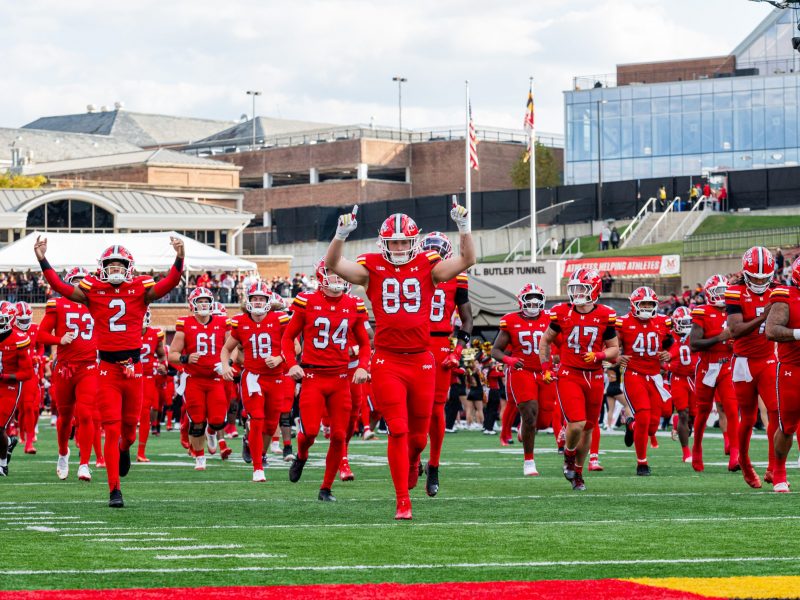
Senior Christine Conlon’s alarm goes off every Friday at 4:45 a.m.
After she wakes up, she twists her long ombre hair into a bun, puts on her khaki uniform and gets picked up by other midshipmen outside her Courtyards apartment. Together they make the 30-minute commute to George Washington University.
Because this university’s campus does not currently house a Navy ROTC program, students like Conlon — “crosstown midshipmen” — travel more than 15 miles to George Washington and take classes as part of the Consortium of Universities of the Washington Metropolitan Area Program, which also includes Georgetown University, Howard University and the Catholic University of America.
But starting in the fall 2016 semester, a commute like Conlon’s will no longer be necessary.
This university signed a contract earlier this month to bring a Navy ROTC unit to this campus, said Lt. Matthew Comer, Naval Service Training Command public affairs officer. This university already hosts Air Force and Army ROTC programs.
“This will allow the University of Maryland to have all branches of the military and Department of Defense represented on the University of Maryland campus, which I think will significantly enhance the reputation and prestige of the University of Maryland system,” said Commander Stew Wennersten, an officer with the George Washington Naval ROTC program.
This university first applied for a Navy ROTC unit in 1945 and updated its application in 1982. Following a series of conversations that picked up in 2011, the University of Maryland Consortium between this university and the University of Maryland, Baltimore County has been approved to bring the first Navy ROTC unit to this state.
Through the consortium, this university and UMBC will have staff assigned to the schools, and students will take classes at their own university, Comer said.
“They’ll basically share a staff,” he said. “So the commanding officer will be at one university and the executive officer will be at another university. The students will interact but won’t have to go back and forth.”
Though senior Joseph Piccinini said he learned time-management skills as a “crosstown midshipmen,” having Navy ROTC on the campus would have given him more time to focus on other classes.
On Tuesdays, the mechanical engineering major leaves George Washington at about 9:30 a.m., drops off the other midshipmen in his carpool all over the campus and then has to make it to his senior capstone course starting at 11 a.m.
“If the unit was at Maryland, I wouldn’t know D.C. the way I do now, but it would’ve been easier in terms of having to get down there and being able to balance my UMD and ROTC life,” he said.
Beyond the added convenience, Comer said another benefit of bringing a unit to this university is promoting the ROTC presence on the campus. Student midshipmen currently only wear uniforms while at George Washington.
“Now, the ROTC students and civilian students will get to interact in a way they haven’t before,” he said. “It’s important for students who are entering leadership roles in industry and government and students who are entering leadership roles in the military to share ideas and form a bond during their college years.”
Conlon agreed and said she hopes increased awareness attracts more students to the unit, which currently has 20 midshipmen, according to Samantha Robaina, an assistant in the Office of the Registrar.
“It’ll be really interesting to see it grow,” Conlon said. “It’ll be really cool for the students to see the presence of the Navy ROTC on this campus.”
The consortium will form in fall 2015, and students applying this summer for a Navy ROTC scholarship will see this university appear on their forms, Wennersten said. Sophomores who are now enrolled at George Washington will be the first to graduate from this university’s unit.
The first year will be devoted to planning, as Navy and university officials will focus on issues such as staffing, which is provided by the Navy, and office space, which is provided by the university.
Donna Hamilton, undergraduate studies dean, said the information about where the Navy ROTC facilities will be housed is not yet being released. The Army and Air Force ROTC offices are located in Cole Field House, which will undergo renovations beginning December 2015 to become an indoor football practice facility.
Officials are planning a signing ceremony for sometime this spring, Comer said.
“Once it’s up and running, it’s certainly a good idea and will certainly maximize the number of naval officers being produced in this area,” Wennersten said.



